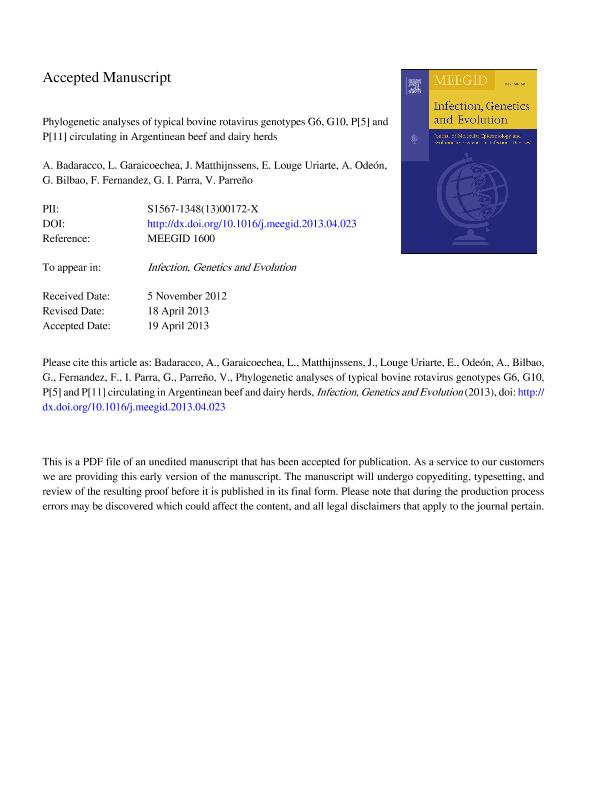Mostrar el registro sencillo del ítem
dc.contributor.author
Badaracco, Alejandra

dc.contributor.author
Garaicoechea, Lorena Laura

dc.contributor.author
Matthijnssens, J.
dc.contributor.author
Louge Uriarte, Enrique Leopoldo

dc.contributor.author
Odeón, Anselmo Carlos

dc.contributor.author
Bilbao, Gladys Noemí

dc.contributor.author
Fernandez, Fernando
dc.contributor.author
Parra, G. I.
dc.contributor.author
Parreño, Gladys Viviana

dc.date.available
2017-09-13T20:24:33Z
dc.date.issued
2013-04
dc.identifier.citation
Badaracco, Alejandra; Garaicoechea, Lorena Laura; Matthijnssens, J.; Louge Uriarte, Enrique Leopoldo; Odeón, Anselmo Carlos; et al.; Phylogenetic analyses of typical bovine rotavirus genotypes G6, G10, P[5] and P[11] circulating in Argentinean beef and dairy herds; Elsevier; Infection, Genetics and Evolution; 18; 4-2013; 18-30
dc.identifier.issn
1567-1348
dc.identifier.uri
http://hdl.handle.net/11336/24202
dc.description.abstract
Group A rotavirus (RVA) is one of the main causes of neonatal calf diarrhea worldwide. RVA strains affecting Argentinean cattle mainly possess combinations of the G6, G10, P[5] and P[11] genotypes. To determine RVA diversity among Argentinean cattle, representative bovine RVA strains detected in diarrheic calves were selected from a survey conducted during 1997–2009. The survey covered the main livestock regions of the country from dairy and beef herds. Different phylogenetic approaches were used to investigate the genetic evolution of RVA strains belonging to the prevalent genotypes. The nucleotide phylogenetic tree showed that all genotypes studied could be divided into several lineages. Argentinean bovine RVA strains were distributed across multiple lineages and most of them were distinct from the lineage containing the vaccine strains. Only the aminoacid phylogenetic tree of G6 RVA strains maintained the same lineages as observed at the nucleotide level, whereas a different clustering pattern was observed for the aminoacid phylogenetic trees of G10, P[5] and P[11] suggesting that the strains are more closely related at the aminoacid level than G6 strains. Association between P[5] and G6(IV), prevalent in beef herd, and between P[11] and G6(III) or G10 (VI and V), prevalent in dairy herds, were found. In addition, Argentinean G6(III), G10, P[5] and P[11] bovine RVA strains grouped together with human strains, highlighting their potential for zoonotic transmission. Phylogenetic studies of RVA circulating in animals raised for consumption and in close contact with humans, such as cattle, contribute to a better understanding of the epidemiology of the RVA infection and evolution.
dc.format
application/pdf
dc.language.iso
eng
dc.publisher
Elsevier

dc.rights
info:eu-repo/semantics/openAccess
dc.rights.uri
https://creativecommons.org/licenses/by-nc-nd/2.5/ar/
dc.subject
Bovine
dc.subject
Diarrhea
dc.subject
Phylogeny
dc.subject
Rotavirus
dc.subject
Typing
dc.subject.classification
Bioquímica y Biología Molecular

dc.subject.classification
Ciencias Biológicas

dc.subject.classification
CIENCIAS NATURALES Y EXACTAS

dc.title
Phylogenetic analyses of typical bovine rotavirus genotypes G6, G10, P[5] and P[11] circulating in Argentinean beef and dairy herds
dc.type
info:eu-repo/semantics/article
dc.type
info:ar-repo/semantics/artículo
dc.type
info:eu-repo/semantics/publishedVersion
dc.date.updated
2017-09-12T16:30:57Z
dc.journal.volume
18
dc.journal.pagination
18-30
dc.journal.pais
Países Bajos

dc.journal.ciudad
Ámsterdam
dc.description.fil
Fil: Badaracco, Alejandra. Instituto Nacional de Tecnología Agropecuaria. Centro de Investigación en Ciencias Veterinarias y Agronómicas. Instituto de Virología; Argentina. Consejo Nacional de Investigaciones Científicas y Técnicas; Argentina
dc.description.fil
Fil: Garaicoechea, Lorena Laura. Instituto Nacional de Tecnología Agropecuaria. Centro de Investigación en Ciencias Veterinarias y Agronómicas. Instituto de Virología; Argentina. Consejo Nacional de Investigaciones Científicas y Técnicas; Argentina
dc.description.fil
Fil: Matthijnssens, J.. University of Leuven. Rega Institute for Medical Research; Bélgica
dc.description.fil
Fil: Louge Uriarte, Enrique Leopoldo. Instituto Nacional de Tecnología Agropecuaria. Centro Regional Buenos Aires Sur. Estación Experimental Agropecuaria Balcarce. Área de Investigación en Producción y Sanidad Animal; Argentina. Consejo Nacional de Investigaciones Científicas y Técnicas; Argentina
dc.description.fil
Fil: Odeón, Anselmo Carlos. Instituto Nacional de Tecnología Agropecuaria. Centro Regional Buenos Aires Sur. Estación Experimental Agropecuaria Balcarce. Área de Investigación en Producción y Sanidad Animal; Argentina
dc.description.fil
Fil: Bilbao, Gladys Noemí. Universidad Nacional del Centro de la Provincia de Buenos Aires. Facultad de Ciencias Veterinarias; Argentina
dc.description.fil
Fil: Fernandez, Fernando. Instituto Nacional de Tecnología Agropecuaria. Centro de Investigación en Ciencias Veterinarias y Agronómicas. Instituto de Virología; Argentina
dc.description.fil
Fil: Parra, G. I.. National Institutes of Health; Estados Unidos
dc.description.fil
Fil: Parreño, Gladys Viviana. Instituto Nacional de Tecnología Agropecuaria. Centro de Investigación en Ciencias Veterinarias y Agronómicas. Instituto de Virología; Argentina. Consejo Nacional de Investigaciones Científicas y Técnicas; Argentina
dc.journal.title
Infection, Genetics and Evolution

dc.relation.alternativeid
info:eu-repo/semantics/altIdentifier/doi/http://dx.doi.org/10.1016/j.meegid.2013.04.023
dc.relation.alternativeid
info:eu-repo/semantics/altIdentifier/url/http://www.sciencedirect.com/science/article/pii/S156713481300172X
Archivos asociados
